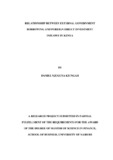Relationship between external government borrowing and foreign direct investment inflows in Kenya
| dc.contributor.author | Kiungah, Daniel N | |
| dc.date.accessioned | 2019-01-15T13:17:55Z | |
| dc.date.available | 2019-01-15T13:17:55Z | |
| dc.date.issued | 2018 | |
| dc.identifier.uri | http://hdl.handle.net/11295/104783 | |
| dc.description.abstract | Lack of domestic financial resources has been identified as the main challenge facing Less Developed Countries as they seek to attain sustained and equitable economic growth and development. This has led to heavy reliance by the LDCs on external sources of capital such as foreign aid, foreign direct investment, remittances and concessional lending. Foreign direct investment inflow movements into a country are influenced by changes in many economic variables that lead to prospect changes. Countries need to seek new ways of attracting FDI stock since motives of investors are varying over. Research is therefore crucial for investment decision making and predictability of FDI inward stock is imperative. This study sought to determine the effect of external government borrowing on foreign direct investments inflows in Kenya. The independent variable was external government borrowing as measured by quarterly external government borrowing in natural logarithm form. The control variables were economic growth as measured by quarterly GDP growth rate and inflation rates as measured by quarterly CPI. FDI inflows in Kenya were the dependent variable which the study sought to explain and it was measured by FDI inflows in the country on a quarterly basis. Secondary data was collected for a period of 10 years (January 2008 to December 2017) on a quarterly basis. The study employed a descriptive research design and a multiple linear regression model was used to analyze the relationship between the variables. Statistical package for social sciences version 21 was used for data analysis purposes. The results of the study produced R-square value of 0.644 which means that about 64.4 percent of the variation in FDI inflows in Kenya can be explained by the four selected independent variables while 35.6 percent in the variation was associated with other factors not covered in this research. The study also found that the independent variables had a strong correlation with FDI inflows (R=0.803). ANOVA results show that the F statistic was significant at 5% level with an F statistic of 21.725. Therefore the model was fit to explain FDI inflows in Kenya. The results further revealed that individually, external government borrowing and economic growth are not significant determiners of FDI inflows in Kenya while inflation rate is a significant determiner. This study recommends that there is need for policy makers to regulate external government borrowing levels prevailing in the country bearing in mind that they can influence FDI inflows in the country. | en_US |
| dc.language.iso | en | en_US |
| dc.publisher | University of Nairobi | en_US |
| dc.rights | Attribution-NonCommercial-NoDerivs 3.0 United States | * |
| dc.rights.uri | http://creativecommons.org/licenses/by-nc-nd/3.0/us/ | * |
| dc.title | Relationship between external government borrowing and foreign direct investment inflows in Kenya | en_US |
| dc.type | Thesis | en_US |



